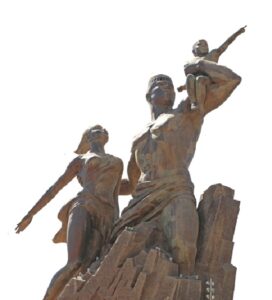
By Larzsolice
Introduction
In a world of corporations and industrialised economies, it is easy to loose sight of the value that culture holds as a resource. This is particularly true in Africa, which is probably the continent with the highest cultural diversity. Colonial borders has created a situation where most African countries are homes to multiple cultures each.
Developing this cultural reservoir has the potential to create a booming industry as tourists and pilgrims are attracted to cultural centres. Culture is also a resource that can give poor people an opportunity to achieve self-dignification, since participating in cultural development programs will give them skills that can be used in the tourism industry. In this way, the preservation of heritage and the production of new heritage becomes a means of uplifting the poor.
The influence of history on poverty is not an obstacle since actions in the present have a direct impact on the future. Solving poverty relies on our actions in the present day, the legacy that we build for our descendants.
In the arguments that follow the basic premise is that the only thing that is needed to trigger an African Renaissance is the establishment of mother-tongue universities for every cultural group in Africa. However, in order to couple cultural development programs with income from the tourism industry, I propose that these universities be surrounded by cultural hubs that house art schools, museums and most importantly a festival square for celebrations.
By creating these cultural campuses you promote behaviour like tourism and pilgrimage because there are centralised locations where the cultures can be experienced or reconnected with. The aim is as much to attract pilgrims to reconnect with their culture as it is to attract tourists to witness the African Renaissance.
We live in the age of mixed cities, where it is easy to loose sight of one’s culture. The cultural centres I envision are imagined as places where people can go to reconnect with their cultures, and therefore pilgrimage is an integral factor in my vision of an African Renaissance.
Cultural resources in the battle against poverty
When you look at poverty as a problem in Africa, there are certain causes of poverty that can be addressed via an African Renaissance. Lack of skills can be addressed by involving the poor in the cultural development programs using bursaries or other funding initiatives. Poor quality education arises when students are forced to learn in languages that are foreign to them, mother-tongue universities can set new curricula for schools. Economic troubles can be circumvented if a large portion of the funding for these cultural programs comes from tourism and donations.
I am not claiming that the African Renaissance will cure poverty on it’s own, but neither will corporate jobs. In order to eliminate poverty it needs to be addressed on multiple fronts, and developing cultural heritage is one of these fronts. The main importance of an African Renaissance in the battle against poverty is that it will give people a sense of hope and cultural pride, and this might be enough to push Africa out of its long depression.
A vision of an African Renaissance
I have given much thought into how an African Renaissance might be triggered and have developed the following system out of the principles of custodial multiculturalism. Custodial multiculturalism states that a multicultural society can only be stable if it has stable cultural centres, and that custodial organisations need to be created to preserve cultural heritage while developing new heritage for the future. The motto is “modernise, not Westernise”. Please note that what follows is only a suggestion, and I encourage you to think about your own version of an African Renaissance.
Therefore, the foundation on which my vision of an African Renaissance is built is what I call the Cultural Dignity Fund, or simply the Dignity Funds. These are NGOs involving the traditional leaders of a particular culture that are set up for every culture with a mandate to preserve and produce cultural heritage. Donations to this fund will be used firstly to construct the cultural hubs, but will also be used to provide bursaries to students using poverty as the main criterion. Donating to the Dignity Funds can be marketed as a matter of cultural pride: a contribution to the future of their culture. They are called Dignity Funds because they provide the poor with an opportunity to achieve self-dignification by participating in cultural development programs.
The first task of the Dignity Funds will be to establish mother-tongue universities around which the cultural centres will be built. The initial task of these universities will be to translate and publish books in their mother tongue. Particular emphasis should be placed on translating children’s books so that reading stories to your children in mother tongue can be marketed as a source of cultural pride. Over time these mother-tongue universities will help expand the languages so that the universities can take on more subjects and become prober tertiary education facilities.
Next on the priority list is cultural arts schools, which will include art schools, dance schools and films schools. These will be tasked at studying traditional arts and dances, and using these to inspire modern forms. If every culture engages in this project it will produce a high volume of entertainers that use cultural arts to attract tourism money. The film schools are also important because they will document the progress of the cultural development programs and produce video and footage that further attracts tourism.
In association with these cultural art schools, a festival square needs to be built. The edges of the festival square should be markets were tourists and pilgrims can purchase the arts produced in the art schools and the main festival square provides a place where celebrations and festivals can be held to showcase the performing arts of each culture. These festival squares can also be used for ceremonies involving pilgrims, since such ceremonies can provide a sense of reconnection through participation.
In order to complete the cultural campus as a centralised site of cultural development, museums and monuments need to be built around the festival squares. The museums will provide an anchor and a reservoir for the history and lore of each culture while the monuments will provide a source of cultural pride. Both will also attract tourists and pilgrims from the cities.
All of this activity in the cultural campuses will also necessitate hotels and restaurants as well as other spin-off industries. As such, these cultural campuses represent an opportunity to create a lot of jobs outside of the tourism industry as well.
The past is not an obstacle when you build a future
When I think of the potential impact that an African Renaissance can have on the future, it becomes clear to me that the challenges of the past are not an obstacle to inspiring an African Renaissance. The challenge lies in building the infrastructure, not in overcoming the legacy of the past. True reconciliation is to be put on the same footing, and the African Renaissance will give African cultures that which Eurasian cultures have: mother-tongue universities that serves as centres of culture. Honestly, it is shocking that this hasn’t been done already…













